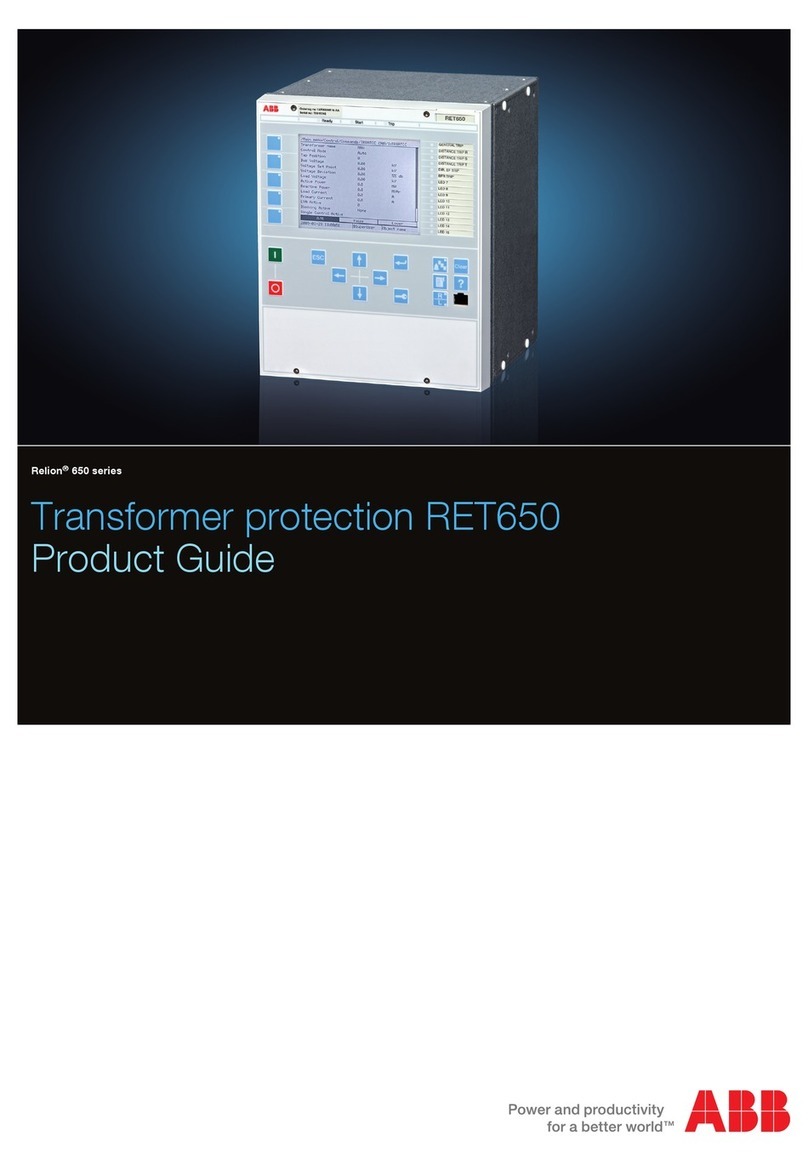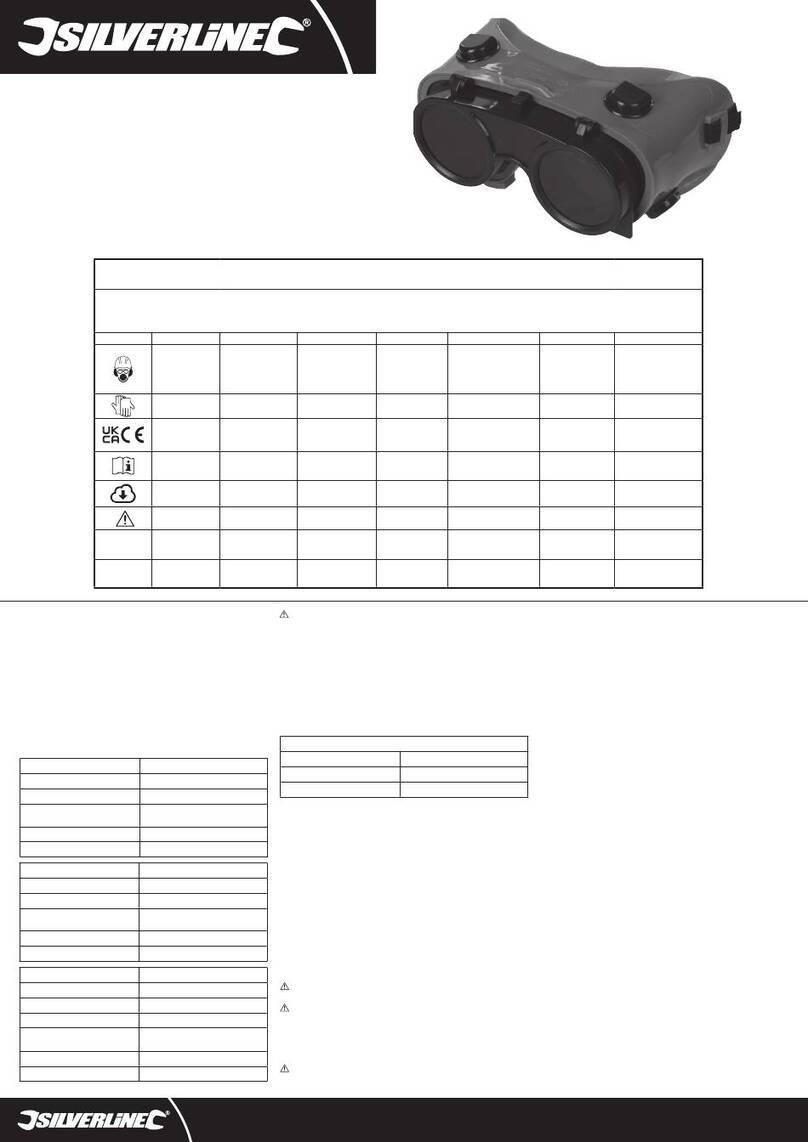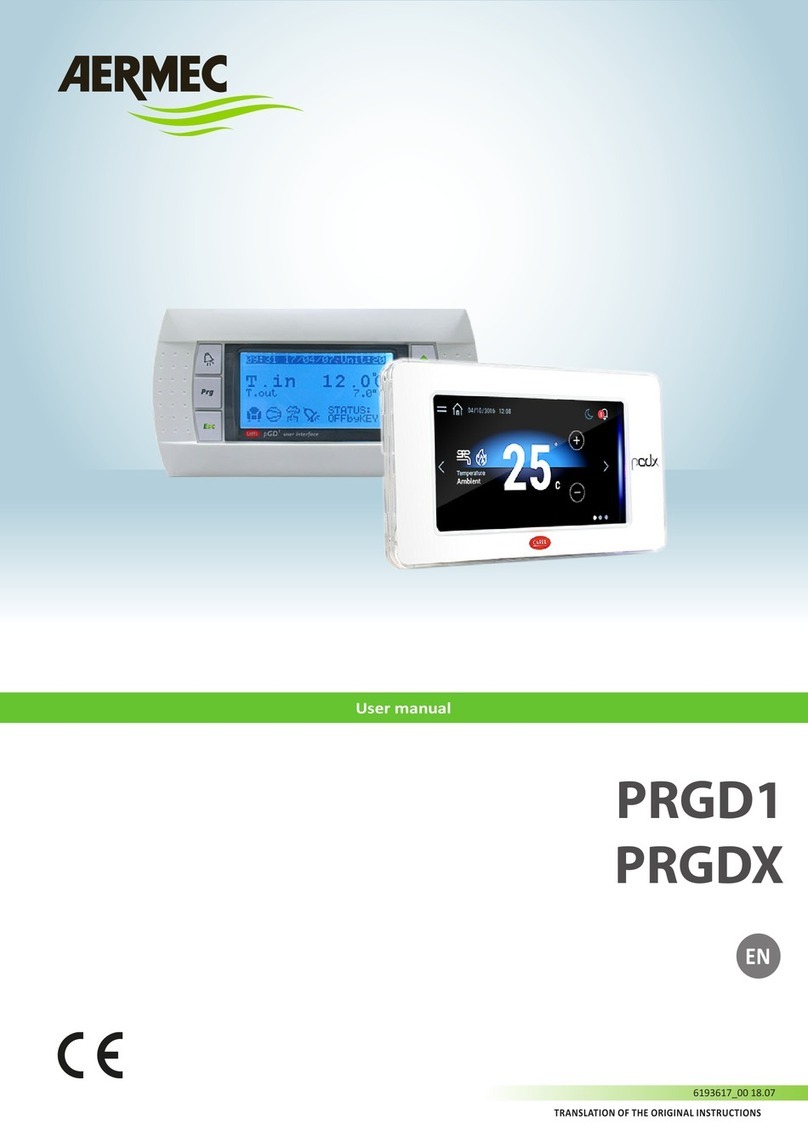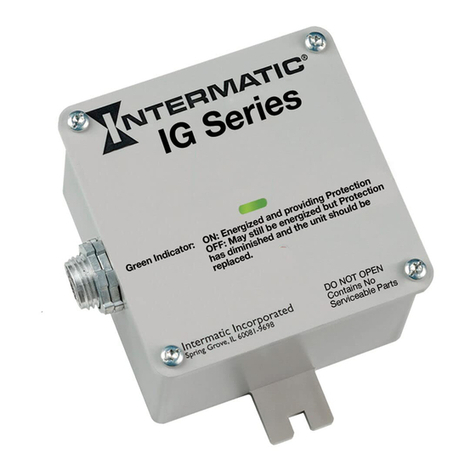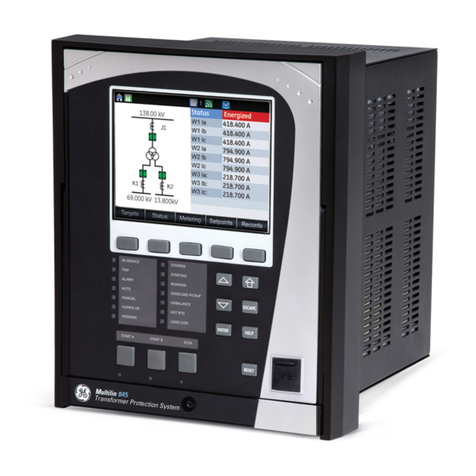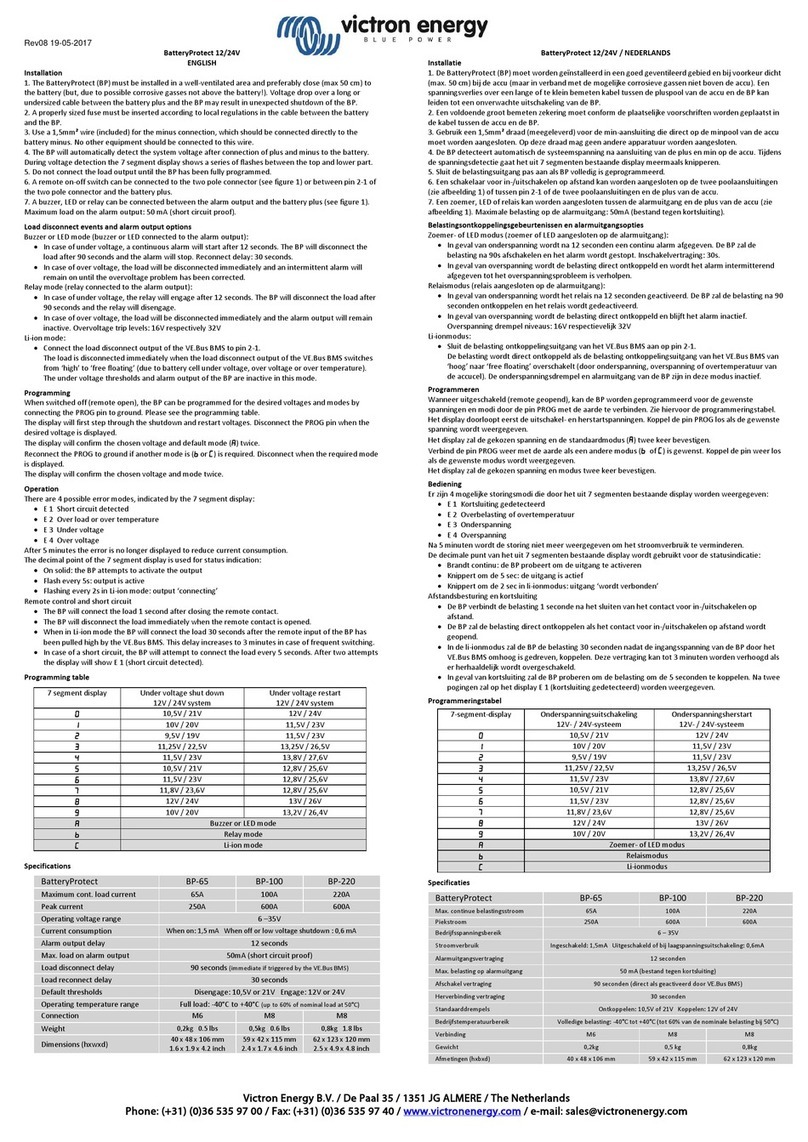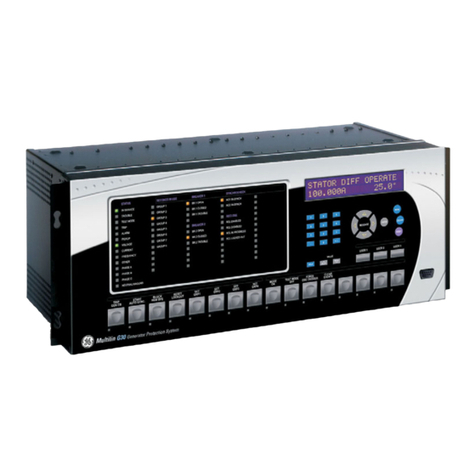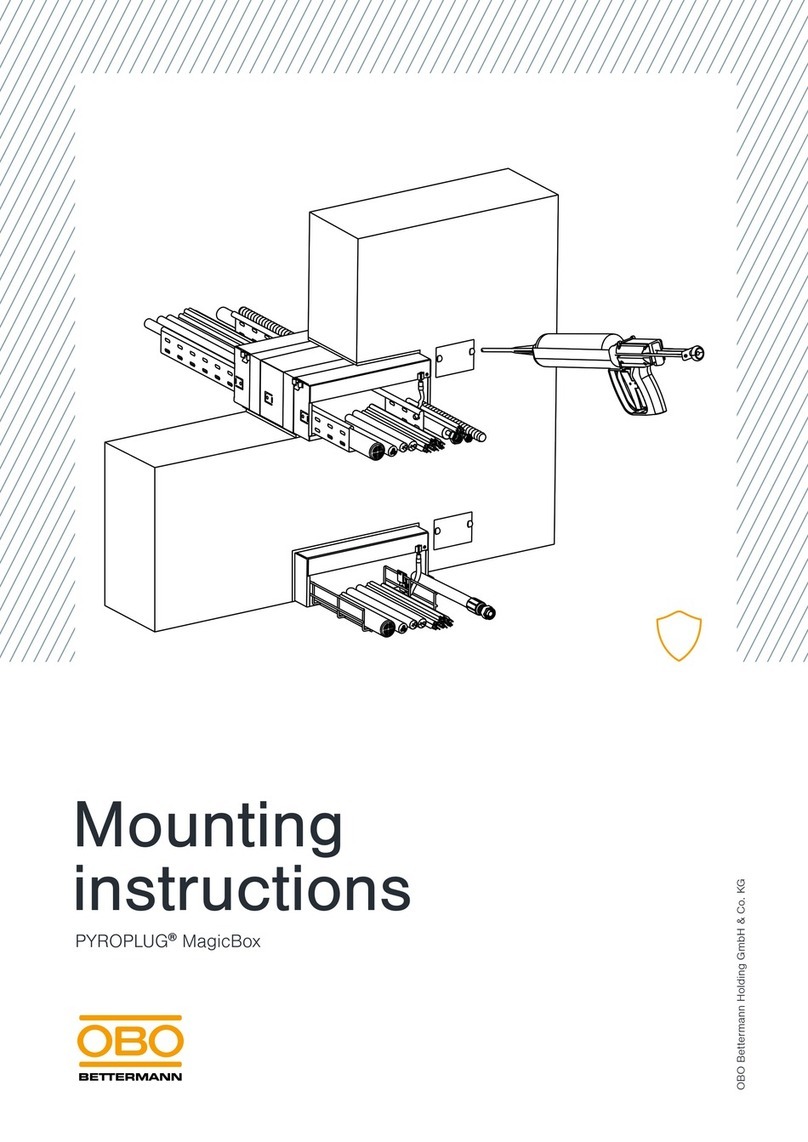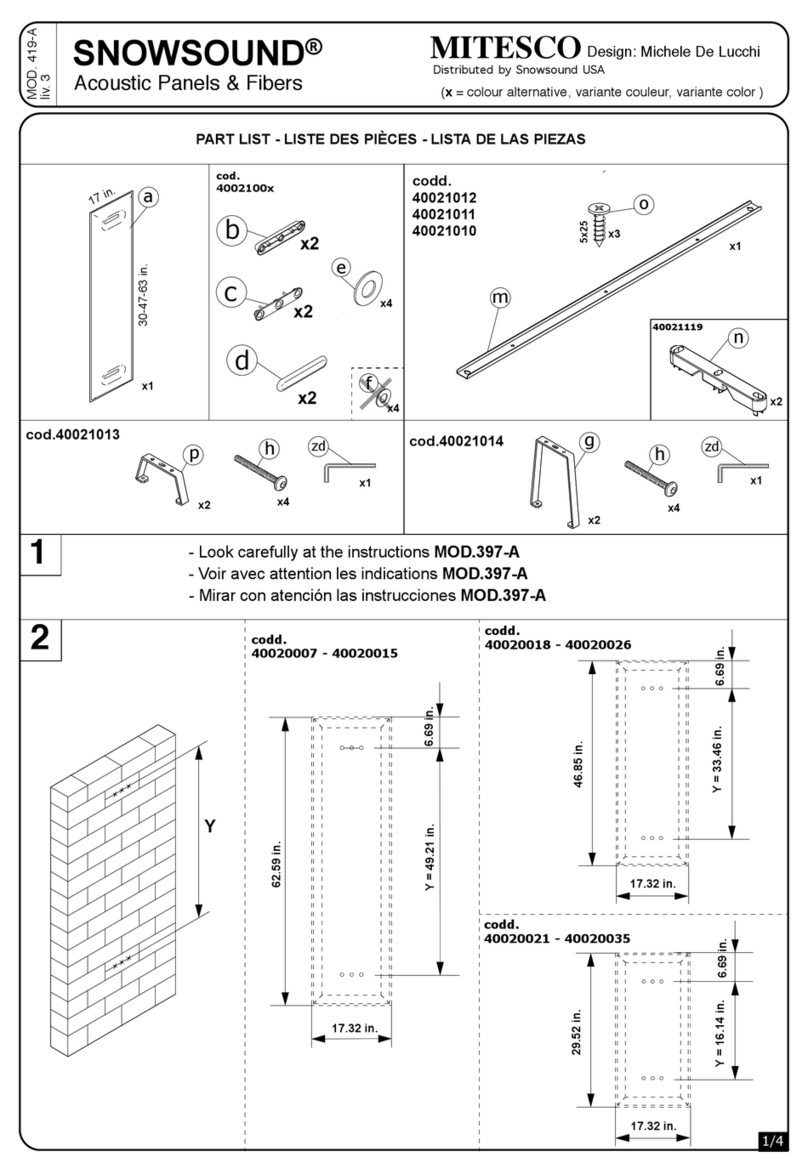dehn DEHNcare APS Series Operation manual

Verwenderinformation
Störlichtbogengeprüfte Schutzschirme DEHNcare
APS ... und APS T ...
Publication No. 1919 / Update 08.19 Mat.-No. 3013167 www.dehn-international.com © Copyright 2019 DEHN SE + Co KG
DE GB FR ES IT PT NL DK SE FI CZ TR HU NO PL RUCN

2
Dieses Dokument enthält alle erforderlichen Informationen zur Verwendung und Wartung der DEHNcare-Serie. Um richtig geschützt zu
sein, müssen Sie diese Verwenderinformation vor der Verwendung sorgfältig durchlesen! Nichtbeachtung kann zu schweren Körper-
verletzungen führen. Für die Konformitätserklärung (PDF) geben Sie die Artikelnummer wie am Etikett abgebildet in das Suchfeld auf
www.dehn.de ein.
Allgemeine Hinweise:
ÂDer Schutzschirm darf Sonneneinstrahlung nicht länger als nötig ausgesetzt werden.
ÂDer Schutzschirm ist zum Schweißen nicht geeignet.
ÂDer Schutzschirm darf nicht längere Zeit offenem Feuer ausgesetzt werden.
ÂDie Oberäche kann sich bei elektromagnetischer Strahlung erhitzen.
ÂDen Schutzschirm austauschen, wenn er mit Chemikalien, Ölen oder Fetten in Berührung gekommen ist.
ÂDen Schutzschirm austauschen, wenn er durch mechanische Einwirkung beschädigt ist.
ÂEs dürfen nur Originalersatzteile verwendet werden.
ÂDer Arbeitsplatz muss ausreichend beleuchtet sein.
ÂDie persönliche Farbwahrnehmung in der Arbeitsumgebung ist zu berücksichtigen.
ÂVerwenden Sie den Schutzschirm nicht wieder, wenn er einem Störlichtbogenzwischenfall ausgesetzt war oder eines oder mehrere
der unter „Wartung, Instandsetzung und Austausch:“, auf Seite 8 angeführten Kriterien zum Austausch desselben erfüllt sind.
ÂDie Schutzschirme sind aus qualitativ hochwertigen Material gefertigt und sind somit für einen langfristigen Einsatz (5 Jahre)
ausgelegt. Als Basismaterial zur Herstellung von störlichtbogengeprüften Schutzschirmen wird Polycarbonat verwendet. Die Halt-
barkeit hängt dabei entscheidend von der Nutzung und Lagerung ab. Grundsätzlich altern Kunststoffe bei UV-Strahlung und sind
empndlich gegen Öle und Schmiermittel. Deshalb muss vor jedem Gebrauch der Schutzschirm (Visier) auf äußere Schäden optisch
überprüft werden und bei mechanischen Schäden, wie z.B. Rissen, Kratzern darf der Schutzschirm nicht zum Einsatz kommen. Daher
wird empfohlen, den Schutzschirm zu ersetzen, falls bereits eines der auf Seite 8 aufgeführten Kriterien erfüllt ist. Aus Sicher-
heitsgründen wird der Anwender aufgefordert, den Überblick über die Nutzungszeit zu behalten und einen geeigneten sicheren
Zeitpunkt für den Austausch zu nden. Dies ist eine allgemeine Sicherheitsempfehlung.
ÂDie Bewegungsfreiheit des Kopfes und die Sicht kann individuell eingeschränkt sein.
ÂWerkstoffe, die in Kontakt mit der Haut des Trägers kommen können, könnten bei empndlichen Personen allergische Reaktionen
hervorrufen.
ÂDEHNcare APS ... schützen gegen Teilchen mit hoher Geschwindigkeit. Wenn diese über üblichen Korrektionsbrillen getragen wer-
den, kann das Übertragen von Stößen für den Träger eine Gefährdung darstellen.
Die Schutzschirme APS ... sind hinsichtlich der Anforderungen zur bedingungsgemäßen Anwendung nach folgenden Normen ge-
prüft:
- NFPA 70E: 2015 (außer APS CL2 SC/FS und APS T CL2 SC/FS)
- ASTM F 2178: 2008 (außer APS CL2 SC/FS und APS T CL2 SC/FS)
- EN 166: 2001, EN 170: 2002
- GS-ET-29: 2011-05
- PSA-Verordnung (EU) 2016/425
Unter https://eur-lex.europa.eu sind die vorgenannten Normen, Prüfgrundsätze und Verordnungen zu nden.
Die Störlichtbogengeprüften Schutzschirme APS ... werden in Kombination mit den Elektriker-Schutzhelmen der Serie ESH
U ... verwendet. Die Schutzschirme APS ... in Kombination mit den Elektriker-Schutzhelmen der Serie ESH U... sind fürArbeiten an oder

3
in der Nähe von unter Spannung (1000 V) stehenden Anlagen zugelassen.
Bei bestimmungsgemäßem Gebrauch bietet die Kombination aus Schutzhelm und Schutzschirm eine hohe Schutzwirkung gegen die
Gefahren eines Lichtbogens. Basierend auf einer Risikoanalyse sind auch darüber hinaus weitere Schutzmaßnahmen wie z.B. das Tragen
von Handschuhen, Schutzkleidung, etc. zu beachten!
Anwendung:
Die typische Gebrauchstemperatur soll zwischen -10°C und 45°C betragen.
Die Schutzschirme APS CL2 SC/APS CL2 FS und APS T CL2 SC/APS T CL2 FS sind Produkte der Störlichtbogenschutzklasse 2 und
der Lichttransmissionsklasse 0 gemäß GS-ET-29. Diese Schutzschirme bieten maximale Lichttransmission und entsprechen den Anfor-
derungen für 'Verbesserte Farberkennung' gemäß EN 170. Unter normalen Arbeitsbedingungen sollte keine zusätzliche Beleuchtung
notwendig sein. Prüfen Sie dennoch Ihre persönliche Farbwahrnehmung in Ihrer Arbeitsumgebung.
Die Schutzschirme APS 12C SC/APS 12C FS und APS T 12C SC/APS T 12C FS sind Produkte der Störlichtbogenschutzklasse 2 und
der Lichttransmissionsklasse 1 gemäß GS-ET-29. Diese Schutzschirme übertreffen die Störlichtbogenschutzanforderungen an die höchste
Störlichtbogenschutzklasse der GS-ET-29 deutlich, erfüllen aber dennoch die Anforderungen für 'Verbesserte Farberkennung' gemäß EN
170. Entsprechend der GS-ET-29 kann bei Produkten der Lichttransmissionsklasse 1 zusätzlich Beleuchtung notwendig sein, um eine
Mindestbeleuchtungsstärke von 30 lux hinter dem Visier zu erreichen.
Die Schutzschirme APS T 20C SC/APS T 20C FS sind Produkte der Störlichtbogenschutzklasse 2 und der Lichttransmissionsklasse 2
gemäß GS-ET-29. Diese Schutzschirme übertreffen die Störlichtbogenschutzanforderungen an die höchste Störlichtbogenschutzklasse
der GS-ET-29, erfüllen aber dennoch die Anforderungen für 'Verbesserte Farberkennung' gemäß EN 170. Entsprechend der GS-ET-29
kann bei Produkten der Lichttransmissionsklasse 2 zusätzlich Beleuchtung notwendig sein um eine Mindestbeleuchtungsstärke von 30
lux hinter dem Visier zu erreichen.
ANMERKUNG: Aufgrund von unterschiedlichen Arbeitsplatzbedingungen prüfen Sie bitte die Notwendigkeit für zusätzliche Beleuch-
tung, wenn Sie einen der o.g. Schutzschirme tragen.
Künstliche Beleuchtung, insbesondere das Licht von Leuchtstoffröhren oder LED-Lampen, könnte mit der Tönung der Schutzschirme Ihre
Fähigkeit, Farben voneinander zu unterscheiden, beeinussen. Um sicher zu stellen, dass Sie unter den lokalen Beleuchtungsbedingun-
gen in der Lage sind, ausreichend gut Farben zu erkennen, empfehlen wir die folgende Prozedur durchzuführen, bevor Sie mit der Arbeit
beginnen:
ÂNehmen Sie Kabelstücke mit Farbkodierungen, die Sie auch an Ihrem Arbeitsplatz vornden;
ÂStellen Sie sicher, dass Sie sich in einer sicheren Umgebung benden, mit einer ausreichenden Beleuchtung (Typ und Intensität);
ÂReinigen Sie Ihren Schutzschirm und inspizieren Sie ihn auf Beschädigungen entsprechend dieser Verwenderinformation (Zögern
Sie nicht, den Schutzschirm auszutauschen falls notwendig.);
ÂSetzen Sie sich den Schutzschirm gemäß der Verwenderinformation auf;
ÂSortieren Sie schnell die Kabel.
Falls Sie Probleme bei der Erkennung der Farbkodierungen bemerken oder eine Prüfung des Sortierergebnisses Sortierfehler zeigt, ist die
Beleuchtung zu schlecht. In diesem Fall könnte die Arbeit zu einem Unfall führen, z.B. zu einem Störlichtbogenunfall.

4
ANMERKUNG: Der Schutzschirm ist zum Schutz der Augen und des Gesichts gegen die mechanischen und thermischen Gefahren eines
Störlichtbogens konzipiert. Nichtsdestotrotz ersetzt er nicht eine Brille, andere Augen- und Gesichtsschutz PSA, Atemschutzmasken oder
weitere PSA, die entsprechend einer Gefährdungsbeurteilung und unter Berücksichtigung der anzuwendenden Arbeitsschutzregularien
für einen ausreichenden Schutz an einem spezischen Arbeitsplatz benötigt wird. Achten Sie auf Kompatibilität der verwendeten PSA.
Varianten:
Die Schutzschirme APS ... sind mit einem Steckclip oder Spannband ausgestattet (siehe Tabelle 1). Sie eignen sich zur Verwendung
mit dem Schutzhelm ESH U... .
Hinweis:
Zum Schutz muss der Schutzschirm immer nach unten geklappt sein. Die Schirmarretierung erfolgt über die beiden am Schirm angebrach-
ten Feststellschrauben. Der Schutzschirm ist nur bei gelöster Feststellschraube zu bewegen (Bild 1, Seite 5 und Bild 2, Seite 6).
STECKCLIP SPANNBAND
Typ Produktbild Typ Produktbild
Box-Test Class 2
APS CL2 SC APS CL2 FS
APS T CL2 SC APS T CL2 FS
Box-Test Class 2
(ATPV 12 cal/cm²)
APS 12C SC APS 12C FS
APS T 12 SC APS T 12C FS
Box-Test Class 2
(ATPV 20 cal/cm²) APS T 20C SC APS T 20C FS
Tabelle 1 Varianten Schutzschirme APS ...

5
Ausführung - STECKCLIP
Der Schutzschirm APS ... SC wird von oben an den Schutzhelm herangeführt und mittels der beiden Steckclips in die dafür vorgese-
henen Aussparungen am Helm bis zum Einrasten eingeschoben. Dabei ist auf einen festen Sitz zu achten (siehe Bild 1).
Hinweis zum Austausch der Visieraufnahme:
Im Bedarfsfall bzw. bei einem möglichen Defekt der Visieraufnahme kann diese entsprechend ausgetauscht werden (siehe hierzu Zubehör
- Tabelle 2, Seite 6 ). Vorab sollte die Visieraufnahme mit Visier vorsichtig vom Schutzhelm gelöst werden.
Die Demontage der Visieraufnahme vom Visier sollte wie folgt durchgeführt werden:
Âbei APS ...Typ müssen zuerst die fünf Arretierungsnasen in die Position der jeweiligen Lochaussparung des Visiers gedreht werden.
Danach kann das Visier von der Visieraufnahme abgenommen werden.
Die Montage der neuen Visieraufnahme bzw. des Visieres erfolgt bei beiden Typen in umgekehrter Reihenfolge
.
Wichtig: Der Kinnschutz des Visieres darf nicht entfernt werden, dieser ist dauerhaft befestigt!
Bild 1 Ausführung - STECKCLIP
Schutzschirm APS ... SC
Steckclip
Feststellschraube
Arretierungsnase
Lochaussparung
Wichtig:
Komplett einrasten lassen
und auf einen festen Sitz
achten!
Steckclip
Feststellschraube
Innenliegende Verriegelung
Schutzschirm APS T ... SC

6
Ausführung - SPANNBAND
Der Schutzschirm APS ... FS wird von vorne an den Schutzhelm herangeführt. Dabei wird der Kantenschutz des Schutzschirmes an
der Schirmkante des Schutzhelmes eingepasst. Gleichzeitig wird das Spannband (Gummi) über die Schale des Schutzhelmes gespannt
(siehe Bild 2).
Schutzschirm APS ... FS
Typ: APS ... FS Typ: APS T ... FS
Bild 2 Ausführung - SPANNBAND
Zubehör:
Typ Beschreibung
VH SC APS
Visieraufnahme mit Steckclip für Schutzschirme
APS CL2 SC
APS 12C SC
ESH U 1000 S... Elektriker-Schutzhelm in mehreren Farben erhältlich.
Tabelle 2 Zubehör
1
2
Aufnahme für
den Kappenrand
Feststellschraube
Spannband

7
Marking:
Die genauen Daten der einzelnen Klassen entnehmen sie der Tabelle 3.
(z.B. 2C-1.2 DEHN 1 B 8-2-0 3 CE 1883 - Aufdruck am Schutzschild)
Box-Test Class 2 Box-Test Class 2
(ATPV 12 cal/cm2)
Box-Test Class 2
(ATPV 20 cal/cm2)
Ultraviolettschutzlter 222
Verbesserte Farberkennung CCC
UV-Schutzstufe 1.2 1.4 1.7
Lichttransmissionsgrad nach EN 170
(Bei Lichttransmissionsgrad unter 74,4% ist eine zusätzliche Beleuchtungsquelle erforderlich.)
VLT: 74,4% - 100% VLT: 58,1% - 74,4% VLT: 43,2% - 58,1%
Optische Klasse 111
Stoß mit mittlerer Energie bei Auftreffgeschwindigkeit von 120 m/s BBB
Beständigkeit gegen Lichtbögen bei Kurzschluss 888
Box-Test Klasse 2 nach GS-ET-29 222
Lichttransmissionsklasse nach GS-ET-29 012
Schutz gegen Flüssigkeitsspritzer 333
CE-Zeichen CE CE CE
Nummer der benannten Stelle (erforderlich für CAT. III-Produkte gemäß
Anhang II der PSA-Verordnung (EU) 2016/425) 1883 1883 1883
Tabelle 3 Marking
Prüf- und Zertizierungsstelle:
ECS GmbH - European Certication Service
Augenschutz und Persönliche Schutzausrüstung
Laserschutz und Optische Messtechnik
Hüttfeldstraße 50
73430 Aalen, Germany
Herstelldatum:
Unter dem aufgedruckten Etikett bendet sich ein Aufkleber mit der Arbeitsauftragsnummer "1808-0356".
Die ersten beiden Ziffern stehen für das Herstellungsjahr (2018), die nächsten beiden bezeichnen den Fertigungsmonat (August) gefolgt
von einem Bindestrich und einer vierstelligen Losnummer.

8
Reinigung:
Reinigung und Pege vor erstmaligem Gebrauch und zwischen aufeinanderfolgenden Benutzungen
ÂGrundsätzlich sind die Schutzschirme peglich zu behandeln.
ÂIst der Schutzschirm verschmutzt so ist er vor und nach der Benutzung mit einem fusselfreien, feuchten Tuch (warmes Leitungswas-
ser) zu reinigen. Bei starker Verschmutzung darf auch Seifenlauge (mild) verwendet werden. Im Handel erhältliche Lösungsmittel
oder organische Verbindungen werden nicht erlaubt, da sie die Oberäche aufweichen und die Materialspannung abbauen können.
ÂDie Schutzhelme und die Schutzschirme dürfen nur im sauberen und trockenen Zustand benutzt werden.
ÂDEHNcare APS ... Schutzschirme sind mit einer permanenten Premium-Anti-Beschlag-Beschichtung ausgestattet. Sollten Sie den-
noch ein Beschlagen der Scheibe feststellen, liegt das an Verschmutzungen, die Sie bitte wie oben beschrieben entfernen.
Transport und Aufbewahrung:
ÂDer Transport und die Aufbewahrung der Schutzschirme hat so zu erfolgen,dass keine Minderung der Gebrauchseigenschaft eintritt.
ÂDer Transport der Schutzschirme sollte zweckmäßigerweise in der dafür vorgesehenen Aufbewahrungstasche erfolgen.
ÂAufbewahrung der Ausrüstung in geschlossenen Räumen oder Fahrzeugen in einem geeigneten Behälter.
ÂLagertemperatur: +5°C - +30°C
ÂKeine direkte Sonneneinstrahlung oder Wärmequelle.
ÂDruck vermeiden.
Schutz vor UV-Strahlung:
Verschiedene Kunststoffe sind empndlich gegen ultraviolette-Strahlung. Die Ausrüstung sollte deshalb nicht länger als nötig direkter
Sonneneinstrahlung ausgesetzt werden.
Wartung, Instandsetzung und Austausch:
Wenn der Schutzschirm nicht in der zurückgeschobenen Position verbleibt, müssen die seitlichen Gelenkschrauben nachgezogen werden.
Der Schutzschirm (einschließlich fest angebrachtem Kinnschutz) muss ausgetauscht werden, wenn er
Âverkratzt oder beschädigt ist
Âeinem Störlichtbogen ausgesetzt war
ÂChemikalien, Ölen oder Schmiermitteln ausgesetzt war*
Âdurch mechanische Einwirkungen beschädigt wurde*
Âseine reguläre Nutzungsdauer erreicht hat (5 Jahre)
Âhoher Hitze oder zu lange dem Sonnenlicht ausgesetzt war*
Âüber längere Zeitspannen Feuer ausgesetzt war*
* ACHTUNG:
Schäden, die durch die vorerwähnten Ursachen entstanden sind, sind eventuell für den Anwender nicht sichtbar.
ENTSORGUNG:
Die hier beschriebenen Produkte und deren Verpackung sind nach Ende der Nutzungsdauer als Kunststoffmüll zu entsorgen.
Diese Verwenderinformation der Schutzschirme ist aufzubewahren!

User information
Arc-fault-tested DEHNcare APS … and APS T … face shields
Publication No. 1919 / Update 08.19 Mat.-No. 3013167 www.dehn-international.com © Copyright 2019 DEHN SE + Co KG
GBGB

2
This document contains all information required for using and maintaining the DEHNcare series. Read this user information carefully
before use to ensure proper protection! Failure to take this information into account may result in serious injury.The declaration of con-
formity (pdf) is available on www.dehn-international.com . Simply enter the Part No. shown on the label in the search box.
General notes:
ÂDo not overexpose the face shield to sunlight.
ÂDo not use the face shield for welding.
ÂDo not expose the face shield to open re for long periods of time.
ÂThe surface of the face shield may get hot when exposed to electromagnetic radiation.
ÂReplace the face shield when it has been exposed to chemicals, oil or grease.
ÂReplace the face shield if it has been damaged by mechanical impact.
ÂOnly use original replacement parts.
ÂMake sure that your work place is sufciently illuminated.
ÂConsider individual colour recognition in the work environment.
ÂNever reuse the face shield if it has been in an arc fault incident of if one or more criteria for replacing the face shield described in
“maintenance, repair and replacement” ( on page 8) are fullled.
ÂThe face shields are made of high-quality material and are thus suited for long-term use (5 years). Polycarbonate is used as a base
material for the production of the arc-fault-tested face shields.The durability of this material heavily depends on its use and storage.
As a rule, UV radiation causes plastics to age and they are sensitive to oil and lubricants. For this reason, the face shield (visor) must
be visually examined for signs of damage prior to each use. If mechanical damage (e.g. cracks, scratches) is found, the face shield
must not be used. Therefore, we recommend replacing the face shield if even one of the criteria listed on page 8 is fullled. For
safety reasons, the user is advised to keep an eye on how long the face shield has been is use and a suitable and safe time for re-
placement. This is a general safety recommendation.
ÂThe view and freedom of movement of the head may be limited.
ÂMaterials that may come in contact with the wearer’s skin may cause allergic reactions.
ÂDEHNcare APS … protects the wearer from high-speed particles. If common corrective glasses are worn under the face shield, the
transfer of impact may present a risk for the wearer.
The APS … face shields are tested according to the following standards:
- NFPA 70E: 2015 (except APS CL2 SC/FS and APS T CL2 SC/FS)
- ASTM F 2178: 2008 (except APS CL2 SC/FS and APS T CL2 SC/FS)
-EN 166: 2001, EN 170: 2002
- GS-ET-29: 2011-05
- PPE Regulation (EU) 2016/425
These standards, test principles and regulations can be found at https://eur-lex.europa.eu.
The arc-fault-tested APS… face shields are used in combination with the safety helmets for electricians of the ESH U …
series. In combination with the safety helmets for electricians of the ESH U … series, APS… face shields are approved for work on or
in the vicinity of live installations (1000 V).
If used as intended, the combination of safety helmet and face shield offers a high degree of protection against the risks of an arc fault.
Further personal protective equipment according to a risk analysis such as gloves, protective clothing, etc. may be required!

3
Application:
The typical temperature of use should be between -10°C and +45°C.
The APS CL2 SC/APS CL2 FS and APS T CL2 SC/APS T CL2 FS face shields have arc fault protection class 2 and light transmission
class 0 according to GS-ET-29. These face shields provide maximum light transmission and meet the requirements for “improved colour
recognition” according to EN 170. No additional illumination is necessary under normal work conditions. Nevertheless, please check your
own personal colour recognition in the work environment.
The APS 12C SC/APS 12C FS and APS T 12C SC/APS T 12C FS face shields have arc fault protection class 2 and light transmission
class 1 according to GS-ET-29. These face shields by far exceed the arc fault protection requirements for the highest arc fault protection
class of GS-ET-29, whilst still meeting the requirements for “improved colour recognition” of EN 170. According to GS-ET-29, additional
illumination may be required for products of light transmission class 1 to achieve a minimum illumination of 30 lux behind the visor.
The APS T 20C SC/APS T 20C FS face shields have arc fault protection class 2 and light transmission class 2 according to GS-ET-29.
These face shields exceed the arc fault protection requirements for the highest arc fault protection class of GS-ET-29, whilst still meeting
the requirements for “improved colour recognition” of EN 170.According to GS-ET-29, additional illumination may be required for pro-
ducts of light transmission class 2 to achieve a minimum illumination of 30 lux behind the visor.
NOTE: Since work place conditions may differ, please check if additional illumination is required when wearing one of the above-men-
tioned face shields.
Articial lighting, in particular the light from uorescent or LED lamps, may affect your ability to distinguish colours due to the tinting of
the face shields. To ensure that you are able to recognise colours sufciently well under the local illumination conditions, we recommend
proceeding as follows before you start work:
ÂUse colour-coded cable sections like the ones to be found at your work place;
ÂEnsure that you are in a safe and sufciently illuminated environment (type and intensity);
ÂClean your face shield and examine it for signs of damage in line with this user information (do not hesitate to replace the face
shield, if necessary);
ÂPut on the face shield according to this user information;
ÂSort the cables quickly.
If you have problems identifying the colour codes or, when you check the results, the cables have been sorted incorrectly, the work place
is not well enough lit. Working there may result in an accident, e.g. an arc fault accident.
NOTE: The face shield is designed to protect the wearer’s eyes and face against the mechanical and thermal dangers presented by an
arc fault. However, it does not replace the goggles, other eye and face protection, respirator masks or other PPE required, according to
a risk assessment and the applicable occupational health and safety regulations, to ensure adequate protection at a specic work place.
Please ensure that the PPE used is compatible.

4
Types:
The APS… face shield comes with a clip or a strap (see Table 1) and is intended for use with ESH U… safety helmets.
Note:
To provide protection, the face shield must always be closed. The position of the shield is adjusted using the two locking screws at the
sides. It can only be moved by loosening these locking screws (Figure 1, page 5 and Figure 2, page 6).
CLIP STRAP
Type Product photo Type Product photo
Class 2 box test
APS CL2 SC APS CL2 FS
APS T CL2 SC APS T CL2 FS
Class 2 box test
(ATPV 12 cal/cm²)
APS 12C SC APS 12C FS
APS T 12 SC APS T 12C FS
Class 2 box test
(ATPV 20 cal/cm²) APS T 20C SC APS T 20C FS
Table 1 Types of APS… face shields

5
Face shield with CLIP
The APS…SC face shield is positioned above the safety helmet and both clips are snapped into the slots on the helmet. Check that
they are secure (see Figure 1).
Note concerning the replacement of the visor holder:
The visor holder can be replaced if necessary or if it is damaged (see accessories, Table 2, page 6). To do so, the visor holder and visor
should be carefully removed from the safety helmet.
Remove the visor holder from the visor as follows:
ÂAPS… type: Turn the ve locking noses so that they t through the relevant slots in the visor. Then remove the visor from the visor
holder.
For both types, the visor is inserted in the new visor holder following this procedure in reverse order.
Important: Do not remove the chin protector of the visor. This is a permanent xture!
Figure 1 Face shield with CLIP
APS… SC face shield
clip
locking screw
locking nose
slot
Important:
Completely snap both clips
into the slot of the helmet
and make sure they are
secure!
clip
locking screw
integrated locking mechanism
APS T…SC face shield

6
Face shield with STRAP
The APS…FS face shield is positioned in front of the safety helmet. The edge protection of the face shield is tted to the edge of the
peak of the safety helmet. At the same time, the strap (rubber) is stretched over the shell of the safety helmet (see Figure 2).
APS…FS face shield
Type: APS ... FS Type: APS T ... FS
Figure 2 Face shield with STRAP
Accessories:
Type Description
VH SC APS
Visor holder with clip for face shields
APS CL2 SC
APS 12C SC
ESH U 1000 S... Safety helmet for electricians available in several colours.
Table 2 Accessories
1
2
slot for peak
locking screw
strap

7
Marking:
Table 3 gives an overview of the exact data of the individual classes
(e.g. 2C-1.2 DEHN 1 B 8-2-0 3 CE 1883 printed on the face shield).
Class 2 box test Class 2 box test
(ATPV 12 cal/cm2)
Class 2 box test
(ATPV 20 cal/cm2)
Ultraviolet lter 222
Improved colour recognition CCC
UV protection level 1.2 1.4 1.7
Visible light transmittance according to EN 170
(additional illumination source required in case of a visible light transmittance below 74.4%)VLT: 74.4% - 100% VLT: 58.1% - 74.4% VLT: 43.2% - 58.1%
Optical class 111
Medium impact energy at an impact velocity of 120 m/s BBB
Resistance to short circuit electrical arc 888
Class 2 box test passed as per GS-ET-29 222
Light transmittance class according to GS-ET-29 012
Protection against splashes of liquids 333
CE mark CE CE CE
ID number of notied body (required for Cat. III products according to
Annex II of the PPE Regulation (EU) 2016/425) 1883 1883 1883
Table 3 Marking
Test and certication body:
ECS GmbH - European Certication Service
Augenschutz und Persönliche Schutzausrüstung
Laserschutz und Optische Messtechnik
Hüttfeldstraße 50
73430 Aalen, Germany
Date of manufacture:
A sticker with the work order number "1808-0356" can be found below the label printed on the face shield.
The rst two digits stand for the year of manufacture (2018), the next two digits show the month of manufacture (August), followed by
a hyphen and a four-digit lot number.

8
Cleaning:
Cleaning and care prior to initial use and before and after each use
ÂBasically, face shields have to be treated with care.
ÂSoiled face shields should be cleaned before and after each use using a lint-free, damp cloth (warm tap water). If heavily soiled,
mild soap may be used. Commercially available solvents or organic compounds are not allowed as they might weaken the surface
and reduce material tension.
ÂSafety helmets and face shields may only be used in a clean and dry state.
ÂDEHNcare APS… face shields feature a permanent premium anti-mist coating. If you should nevertheless notice misting of the face
shield, this is due to dirt which should be removed as described above.
Transport and storage:
ÂFace shields must be transported and stored in such a way that their performance characteristics are not diminished.
ÂFace shields should be transported in the storage bag provided for the purpose.
ÂThe equipment should be stored in closed rooms or vehicles in a suitable container.
ÂStorage temperature: +5°C to +30°C
ÂNo direct sun light or heat source
ÂAvoid compression
Protection against UV radiation:
Some plastics are sensitive to UV radiation. For this reason, the equipment should not be exposed to direct sunlight for longer than is
necessary.
Maintenance, repair and replacement:
If the face shield will not remain in the open position, the pivot screws at the sides must be tightened.
The face shield (including the xed chin protector) must be replaced if it
Âis scratched or damaged
Âhas been exposed to an arc fault
Âhas been exposed to chemicals, oils or lubricants*
Âhas been damaged by mechanical impact*
Âreached its normal life span (5 years)
Âhas been exposed to high temperatures or overexposed to sunlight*
Âhas been exposed to re for a longer period of time*
*Attention:
Damage resulting from the above-mentioned causes may not be visible to the user.
DISPOSAL:
The products described in this user information and their packaging must be disposed of as plastic waste at the end of their life span.
Retain this user information for future reference!

Informations destinées
à l’utilisateur
Écrans de protection testés contre les arcs de défaut DEHNcare
APS ... et APS T ...
Publication No. 1919 / Update 08.19 Mat.-No. 3013167 www.dehn-international.com © Copyright 2019 DEHN SE + Co KG
FR

2
Ce document contient l’ensemble des informations nécessaires à l’utilisation et à l’entretien de la gamme DEHNcare. An de garantir
une bonne protection, ces informations destinées à l’utilisateur doivent être lues attentivement avant toute utilisation ! Le non-respect
de ces informations peut causer des blessures corporelles graves. Pour obtenir la déclaration de conformité (PDF), saisissez le numéro de
référence dans le champ de recherche sur www.dehn-international.com comme indiqué sur l’étiquette.
Remarques générales :
ÂL’écran de protection ne doit pas être exposé aux rayons du soleil plus longtemps que nécessaire.
ÂL’écran de protection ne convient pas aux opérations de soudage.
ÂL’écran de protection ne doit pas être exposé au feu pendant une période prolongée.
ÂLa surface peut chauffer en cas d’exposition à un rayonnement électromagnétique.
ÂIl convient de changer l’écran de protection si celui-ci est entré en contact avec des produits chimiques, des huiles ou des corps gras.
ÂIl convient de changer l’écran de protection si celui-ci est endommagé par une action mécanique.
ÂIl convient d’utiliser uniquement des pièces de rechange d’origine.
ÂLe poste de travail doit être convenablement éclairé.
ÂIl convient de tenir compte de la perception individuelle des couleurs dans l’environnement de travail.
ÂL’écran de protection ne doit pas être réutilisé s’il a été exposé à un épisode d’arcs de défaut, ou si un ou plusieurs critères mentionnés
à la page 8 dans la section « Maintenance, remise en état et remplacement » pour le remplacement de ce dernier sont remplis.
ÂLes écrans de protection sont fabriqués à partir de matériaux de haute qualité et conçus pour une utilisation à long terme (5 ans). Le
polycarbonate est utilisé comme matériau de base dans la fabrication des écrans de protection testés contre les arcs de défaut. La
durée de vie du produit dépend grandement de son utilisation et de son entreposage. En principe, les matériaux plastiques vieillissent
sous l’effet des rayonnements UV et sont sensibles aux huiles et aux lubriants. Par conséquent, il convient de procéder à un contrôle
visuel an de vérier l’absence de dommages externes avant toute utilisation de l’écran de protection (visière) et de ne pas utiliser
l’écran de protection en cas de dommages mécaniques tels que des ssures ou des éraures. Par conséquent, il est recommandé de
remplacer l’écran de protection si l’un des critères mentionnés à la page 8 est rempli. Pour des raisons de sécurité, l’utilisateur est
prié de garder une vue d’ensemble sur la durée d’utilisation et de trouver un moment sûr et approprié pour procéder au remplacement.
Il s’agit d’une consigne générale de sécurité.
ÂLa liberté de mouvement de la tête et la vision peuvent être limitées individuellement.
ÂLes matériaux pouvant entrer en contact avec la peau de l’utilisateur peuvent provoquer des réactions allergiques chez les personnes
sensibles.
ÂLes dispositifs DEHNcare APS… offrent une protection contre les particules à grande vitesse. Lorsque ces dispositifs sont portés sur
des lunettes correctrices habituelles, le transfert des chocs peut représenter un danger pour l’utilisateur.
Les écrans de protectionAPS… sont testés sur la base des normes suivantes concernant les exigences relatives à l’utilisation conforme :
- NFPA 70E: 2015 (sauf pour l’APS CL2 SC/FS et l’APS T CL2 SC/FS)
- ASTM F 2178: 2008 (sauf pour l’APS CL2 SC/FS et l’APS T CL2 SC/FS)
- EN 166: 2001, EN 170: 2002
- GS-ET-29: 2011-05
- Règlement relatif à l’équipement de protection individuelle (UE) 2016/425
Les normes, les réglementations de contrôle et les règlements mentionnés sont disponibles sur https://eur-lex.europa.eu.
Les écrans de protection testés contre les arcs de défautAPS… sont utilisés en combinaison avec les casques de protection
d’électricien de la série ESH U…. Les écrans de protection APS… en combinaison avec les casques de protection d’électricien

3
de la série ESH U… sont admis pour des travaux sur ou à proximité d’installations sous tension (1 000 V).
Dans des conditions normales d’utilisation, l’association du casque de protection et de l’écran de protection offre une protection élevée
contre les risques d’arcs de défaut. D’après une analyse des risques, il convient également de tenir compte des mesures de protection
supplémentaires, telles que le port de gants ou de vêtements de protection !
Utilisation :
La température typique de fonctionnement doit être comprise entre -10 °C et 45 °C.
Les écrans de protection APS CL2 SC/APS CL2 FS et APS T CL2 SC/APS T CL2 FS sont des produits de la classe 2 de protection
contre les arcs de défaut et de la classe 0 de transmission de lumière d’après la norme GS-ET-29. Les écrans de protection offrent une
transmission de lumière maximale et répondent aux exigences de « reconnaissance accrue des couleurs » conformément à la norme EN
170. Aucun éclairage supplémentaire n’est nécessaire dans des conditions normales d’utilisation. Contrôlez toutefois votre perception
individuelle des couleurs dans votre environnement de travail.
Les écrans de protection APS 12C SC/APS 12C FS et APS T 12C SC/APS T 12C FS sont des produits de la classe 2 de protection
contre les arcs de défaut et de la classe 1 de transmission de lumière d’après la norme GS-ET-29. Ces écrans de protection dépassent
nettement les exigences de protection contre les arcs de défaut de la classe supérieure de protection contre les arcs de défaut de la
norme GS-ET-29, mais répondent néanmoins aux exigences de « reconnaissance accrue des couleurs », conformément à la norme EN
170. D’après la norme GS-ET-29, un éclairage supplémentaire peut s’avérer nécessaire pour les produits de la classe 1 de transmission
de lumière an d’atteindre un éclairage minimum de 30 lux derrière la visière.
Les écrans de protection APS T 20C SC/APS T 20C FS sont des produits de la classe 2 de protection contre les arcs de défaut et
de la classe 2 de transmission de lumière, conformément à la norme GS-ET-29. Ces écrans de protection dépassent les exigences de
protection contre les arcs de défaut de la classe supérieure de protection contre les arcs de défaut de la norme GS-ET-29, mais répondent
néanmoins aux exigences de « reconnaissance accrue des couleurs », conformément à la norme EN 170. D’après la norme GS-ET-29, un
éclairage supplémentaire peut s’avérer nécessaire pour les produits de la classe 2 de transmission de lumière an d’atteindre un éclairage
minimum de 30 lux derrière la visière.
REMARQUE : En raison des différentes conditions de travail, contrôlez le besoin d’éclairage supplémentaire lorsque vous portez l’un
des écrans de protection susmentionnés.
La lumière articielle, notamment la lumière provenant des tubes uorescents ou des lampes à DEL, peut inuencer votre capacité à
distinguer les couleurs en raison de la teinte des écrans de protection. An de vous assurer de pouvoir reconnaître correctement les cou-
leurs dans les conditions locales d’éclairage, nous vous recommandons de suivre la procédure suivante avant de commencer le travail :
ÂPrenez les parties de câbles avec un codage couleur se trouvant sur votre poste de travail ;
ÂAssurez-vous de vous trouver dans un environnement sûr, avec un éclairage sufsant (type et intensité);
ÂNettoyez votre écran de protection et contrôlez l’absence de dommages conformément aux informations destinées à l’utilisateur
(n’hésitez pas à remplacer l’écran de protection en cas de nécessité) ;
ÂMettez l’écran de protection conformément aux informations destinées à l’utilisateur ;
ÂTriez rapidement les câbles.
Si vous rencontrez des difcultés lors de la reconnaissance du codage couleur ou si un contrôle du résultat du tri indique une erreur
lors du tri, cela signie que l’éclairage n’est pas adéquat. En pareil cas, le travail peut provoquer un accident, par exemple un accident
impliquant des arcs de défaut..

4
REMARQUE : L’écran de protection est conçu pour protéger les yeux et le visage des dangers mécaniques et thermiques occasionnés
par un arc de défaut.Toutefois, il ne se substitue pas aux lunettes, à un autre équipement de protection individuelle des yeux et du visage,
aux masques de protection respiratoire ou à tout autre équipement de protection individuelle nécessaire pour assurer une protection
suf sante sur le poste de travail, de manière conforme aux analyses des risques et en tenant compte des réglementations relatives à la
protection au travail. Veuillez tenir compte de la compatibilité des équipements de protection individuelle utilisés.
Variantes :
Les écrans de protection APS… sont équipés d’un clip ou d’une sangle de serrage (voir tableau 1). Ils sont appropriés pour être
utilisés avec le casque de protection ESH U ... .
Remarque :
Pour garantir la protection, l’écran de protection doit toujours être rabattu vers le bas. Les deux vis de verrouillage placées sur l’écran
permettent de verrouiller l’écran. L’écran de protection peut être déplacé uniquement lorsque la vis de verrouillage est desserrée (image
1, page 5 et image 2, page 6).
CLIP SANGLE DE SERRAGE
Type Image du produit Type Image du produit
Classe 2 Box Test
APS CL2 SC APS CL2 FS
APS T CL2 SC APS T CL2 FS
Classe 2 Box Test
(ATPV 12 cal/cm²)
APS 12C SC APS 12C FS
APS T 12 SC APS T 12C FS
Classe 2 Box Test
(ATPV 20 cal/cm²) APS T 20C SC APS T 20C FS
Tableau 1 Variantes écrans de protection APS…
This manual suits for next models
11
Table of contents
Languages:
Other dehn Protection Device manuals

dehn
dehn DEHNcare APHO User manual
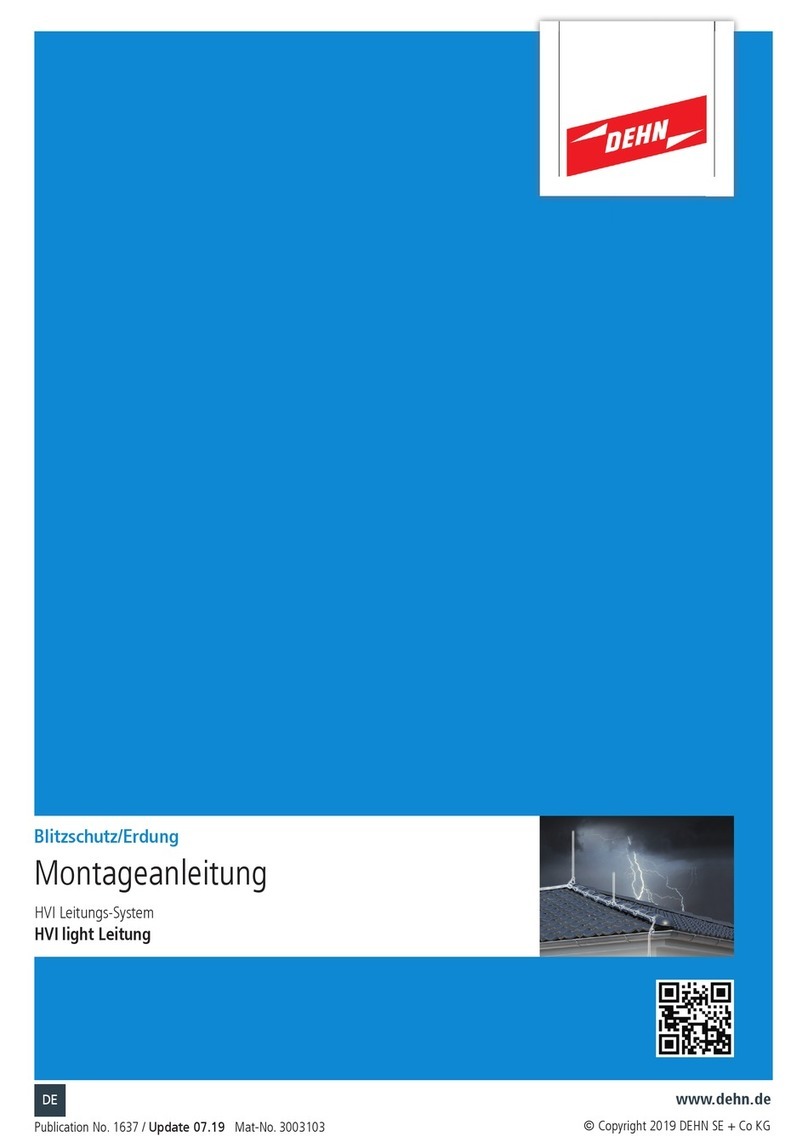
dehn
dehn HVI Conductor User manual
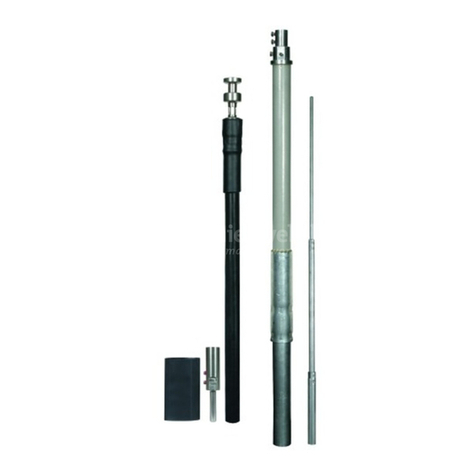
dehn
dehn HVI Conductor User manual
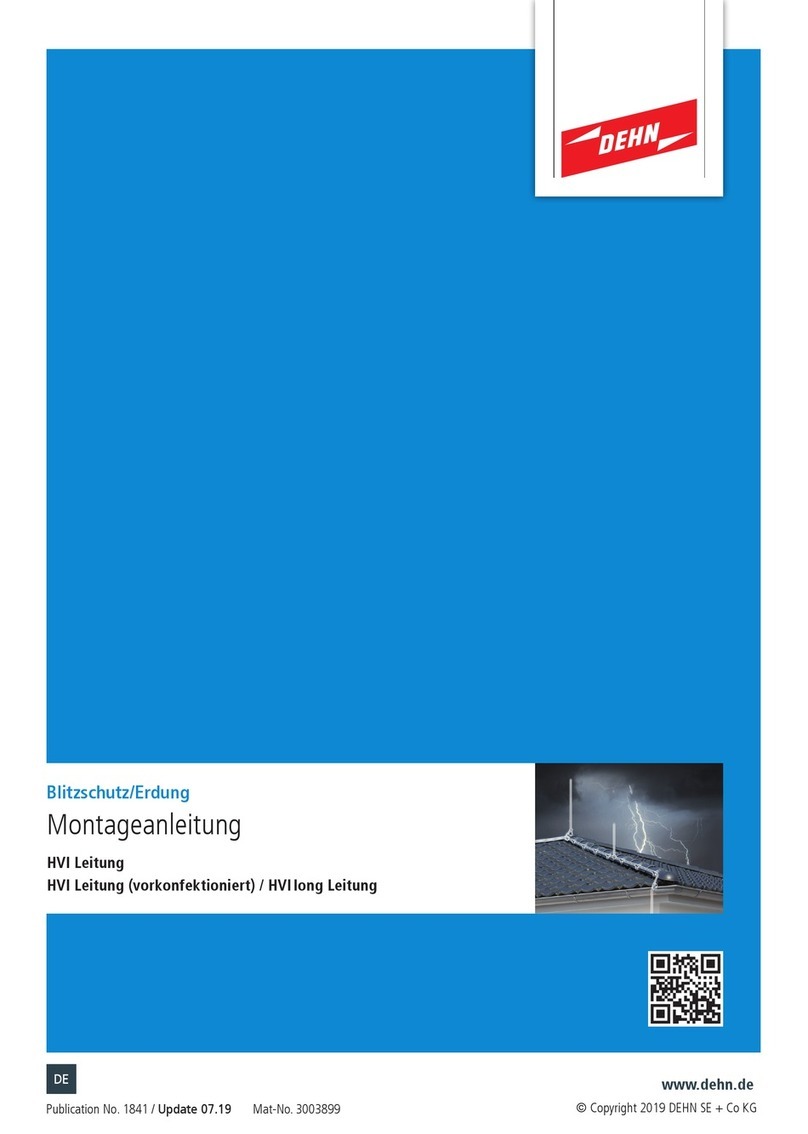
dehn
dehn HVI power User manual

dehn
dehn HVI power User manual
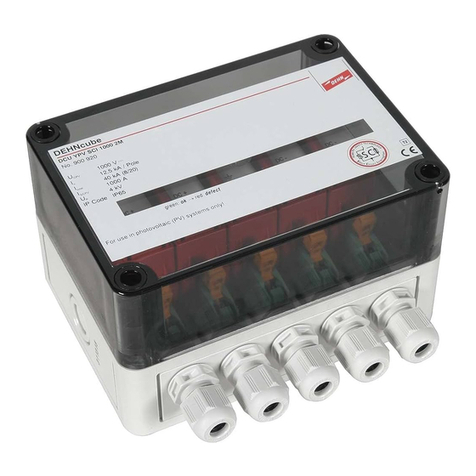
dehn
dehn DCU YPV SCI 1000 1M User manual

dehn
dehn HVI power long User manual
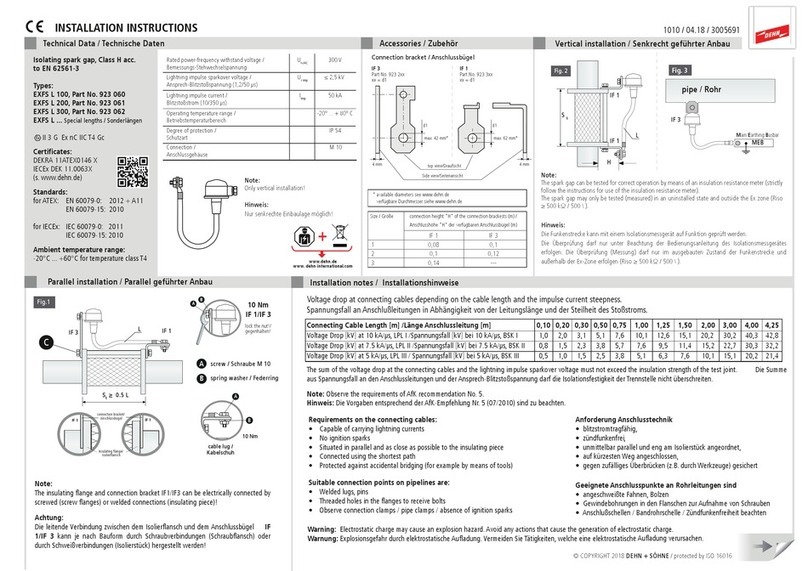
dehn
dehn EXFS L 100 User manual
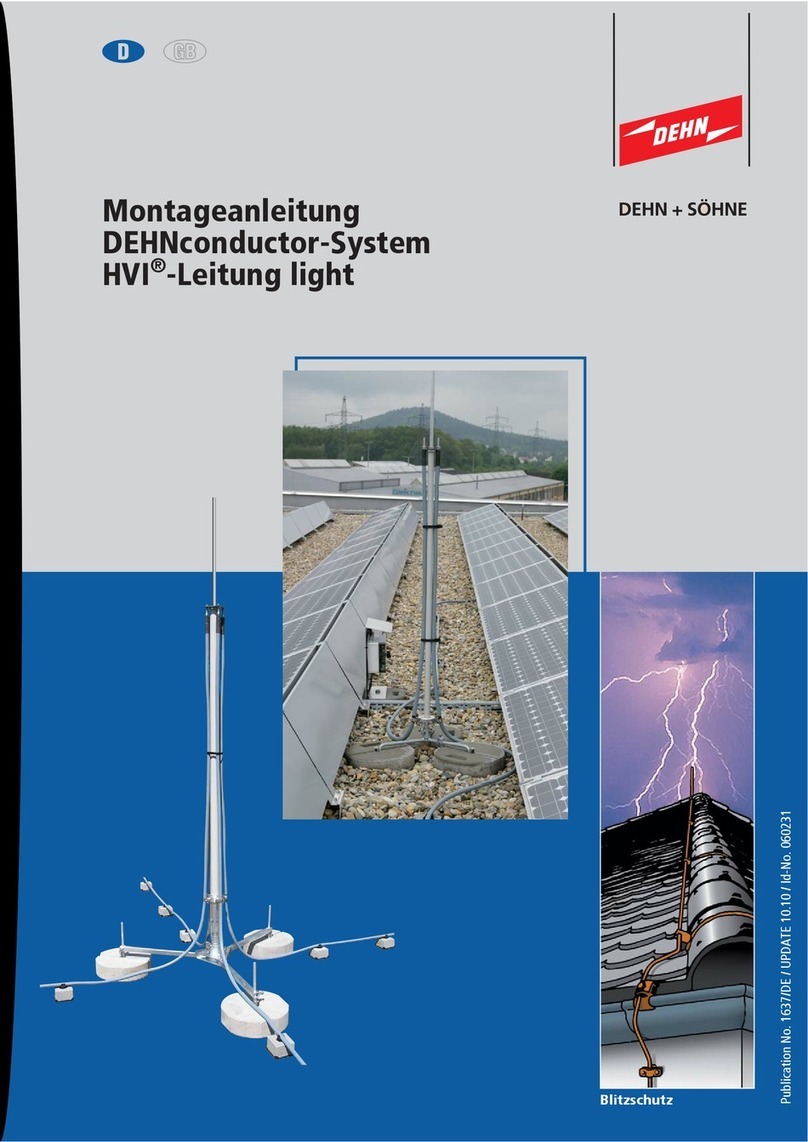
dehn
dehn HVI conductors light User manual
